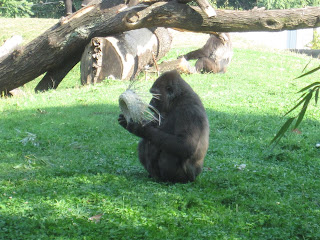
The keeping of animals in captivity can be a controversial issue. Some say that all creatures have a right to freedom and that zoos are exploiting animals for entertainment and profit. Some feel that many zoo animals appear listless and depressed.

The rebuttal that many zoo aficionados spout is that animals are safer in the zoo; their enclosure is free of predators, hunters, poison ivy, and such. I can’t take that tack when defending zoos; I would rather be beset with perils than imprisoned for the rest of my life. Nevertheless, I feel that zoos are important for our society; more important now than ever before.

Zoos not only advance our knowledge on the biology of animals (an essential ingredient for protecting them), but they educate the visitors as well. A good zoo makes it a priority to educate its visitors. Sure, I don’t expect every dolt that walks through the zoo entrance to walk out an expert on biodiversity and conservation. The real power that a zoo holds is its power to help people care, if even for a little bit; and caring is half the battle. I believe that nothing can help the dwindling populations of the polar bear, gorilla, or orangutan if no one ever made an emotional connection with one at the zoo.

Why is the conservation of the elephants important? Besides the emotional attachment we harbor for these large beasts, what do they contribute to us and the ecosystem? Well, they
do plow the dirt a little which helps plants, and their poop provides habitat for certain species of beetle, but it is true that their extinction wouldn’t have a huge impact on the ecosystem. Perhaps I shouldn’t tell you this but I am going to let you in on a little secret: conservationist
use elephants and other interesting or cute creatures to garner support for the protection of whole habitats; habitats that contain many creatures that are essential players in the local ecosystem; creatures like slugs, spiders, brown snakes, and warty toads. The interesting species are called umbrella species and they are vital to conservation efforts.

If there is one thing that has surprised me through this zoo internship is that I really enjoy talking to the visitors. I often spend my breaks among the zoo guests, answering questions about the gorillas and talking about important conservation issues. At first I would approach the idiot families and explain that the gorillas were not all male and that they were great apes, not monkeys. I wanted to stamp out ignorance one doofus at a time, but I soon learned that that was much like trying to stomp the cockroaches downstairs into extinction; impossible! Slowly I came more to enjoy telling the children from obviously smart families all about the gorillas. The information is genuinely appreciated and really seems to stick.

At some point zookeepers have to ask themselves why they do it. There seems to be about as many reasons as there are keepers. One guy I work with is apparently a keeper because it is his only marketable skill; he grew up keeping animals in the family’s business and just never stopped. Unfortunately for him, his career lacks the passion that marks the difference between a good keeper and a great keeper. One keeper is driven by her passion for training the animals. She trains them to push their bodies against the bars to facilitate medical procedures; she trains them to enter adjacent enclosures without a fuss; she would train them to clean up after themselves so that she could spend more time training them if she could.

Roseann is not an adherent to the training school of zookeepery. She believes that training is stressful to the animals and that zookeeping should be done with intuition, with an emphasis on fostering natural behaviors. I can see the wisdom in this but to be dead set against training seems unrealistic; isn’t the absence of training a form of training?

Anyway, Roseann is a zookeeper in part because she thinks that animal education is important. From hearing her talk, I get the idea that she is tenuously clinging to the idea that hopefully she is making a difference somehow. However she justifies herself, I think that the gorillas are very lucky to have her. I would like to model my zookeeping self partly after her.

Besides education, zoos have the role of ark or “seed bank”. While the people of the world are fastidiously endeavoring to wipe out the orangutan in the wild, zoos are carefully keeping the orang genetic stock fresh. Someone once asked me, “What is the point in keeping animals for eventual release into the wild if their habitat no longer exists?” This is a good question but it is also a pessimistic one. Maybe I am naively optimistic to feel that we can one day get a handle on our deforestation and designate a spot for these displaced creatures.

Watching after the gorillas nurtures philosophical thought and the parts of the days that I am alone, raking their yard and enclosures, gives me abundant time to mull over some of these thoughts.

To the people that tell me, “Those gorillas sure look sad,” I ask, “What does a happy gorilla look like?” They never quite know. I’m not so sure either.




























































